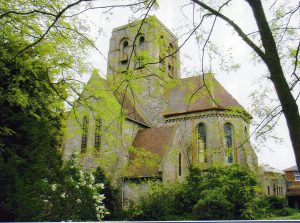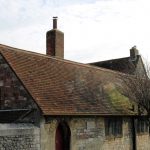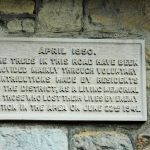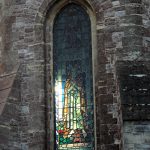St Michael and All Angels Church, Swanmore

The Parish Church of Swanmore, St Michael and All Angels, was built in 1857 in the Medieval French style and consecrated by the Bishop of Winchester in 1863. The Church is cruciform in shape. The central square tower is nearly 90 feet high with three bells hung on the second level. It commands panoramic views across the Solent from the top.
The interior is mainly sandy-coloured brickwork with coloured patterns of red, black and grey bricks together representing the four elements, earth, air, fire and water.
On the north side of the transept is St George’s Chapel, containing the organ and war memorial. The Lady Chapel is on the south side. Its painted ceiling is by Arthur Moore and depicts the nine orders of angels.
The Sanctuary has a high vaulted roof and seven windows with marble shafts. The Chancel screen has twelve arches between polished marble pillars and the twelve apostles stand in the trefoiled niches. The integrated pulpit features Moses, Elijah, St John the Baptist, St Mark, St Luke, St Paul and St Barnabas.
The crucifixion window shows the hands of the Father over the Cross but the memorial stained glass in four other windows was lost during the Second World War.
The High Altar, a centenary gift from the congregation in 1963, is a stone table supported by large stone crosses. The statue of St Michael was a gift in 1970. There are also stone statues of Our Lady and Child given by the Sunday School in 1926 and of St Joseph and St Anne.
Two lancets in the west wall have stained glass depicting St Raphael and St Michael by Lavers and Westlake.
The first vicar, the Rev Richard Wix, was a significant figure, not only in the parish but also, nationally within the Anglican Church. He was part of The Oxford Movement, and fought for the right to burn candles at the altar and incense during services, both illegal practices in the day that could result in the suspension or even imprisonment of the clergy. Rev Wix defied his Bishop’s orders and his curates were refused licences to certificate. He was called to The Court of Arches in London to explain his actions and was heavily fined but still continued the practice.
Within a year, a more moderate Bishop, Samuel Wilberforce, former rector of Brighstone, was appointed and the assistant curates were licensed.
A brass tablet in the Church featuring a bishop is a memorial to Samuel Wilberforce who later became Bishop of Oxford.
Excerpt from RSHG’s book Ryde’s Heritage: Our Town, Your Histories published June 2008
- St Michael & All Angels Church hall
- Plaque St Michaels & All Angels Church hall wall
- Stained glass St Michael & All Angels Church



